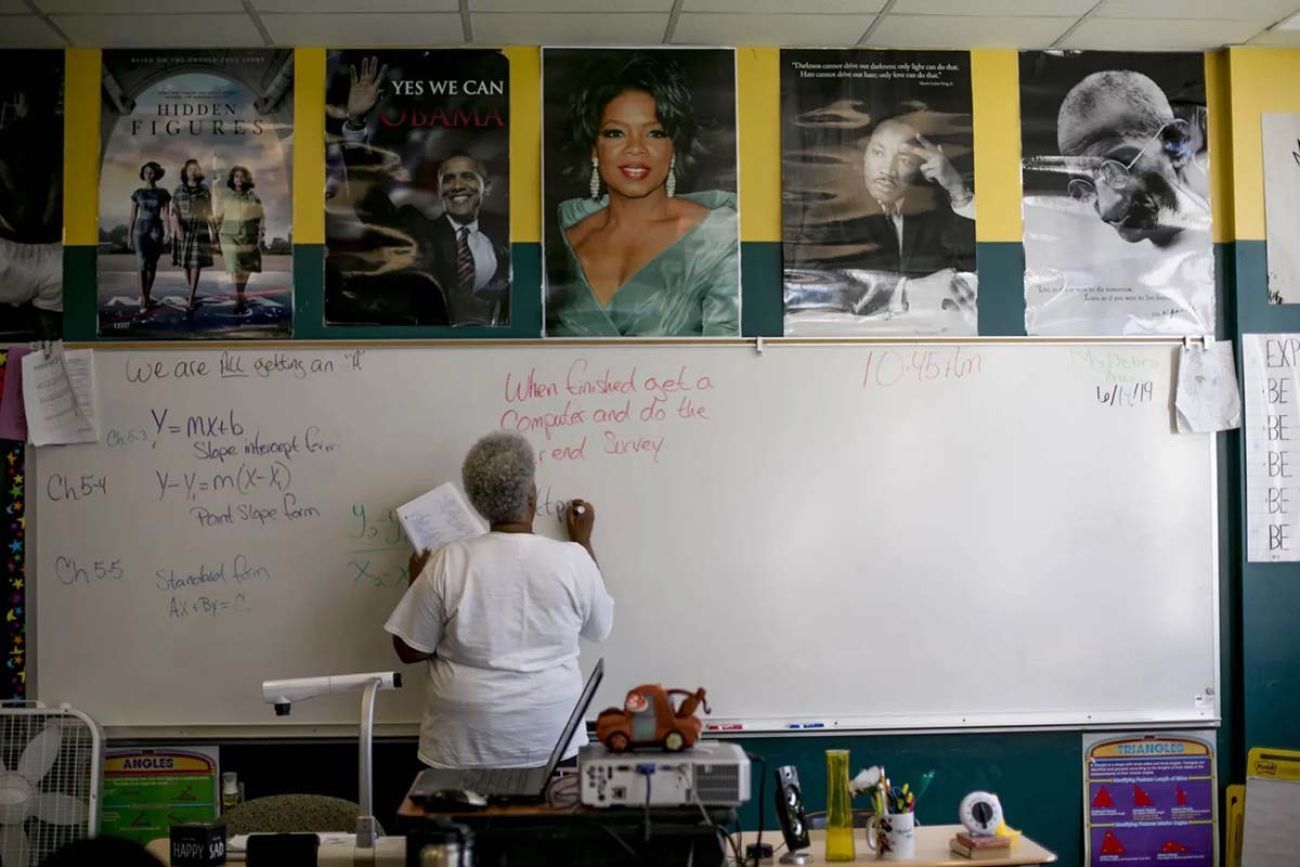Michigan Democrats look to change teacher evaluation system

- Michigan Democrats are preparing bills that will remove student test scores as a factor in teacher evaluations
- Critics say that would lessen accountability, making it difficult to compare performance across school districts
- All agree the current system needs work: 99 percent of teachers last year were ranked as “highly effective” or “effective”
Michigan teacher evaluations will no longer take into account how their students performed on state tests, under legislation soon to be introduced by state Democratic leaders. The proposal is also likely to call for fewer teacher evaluations during the school year.
Supporters of the bills, long sought by teachers’ unions, contend the formulas used to calculate student growth during the school year are imperfect barometers of teacher performance and place too much emphasis on standardized tests.
Critics say softening teacher evaluations lessens accountability at a time when Michigan students continue to post middling scores on state and national tests. The current system, they say, needs to be better implemented, not replaced.
Related:
- Ann Arbor Schools orders ‘Oklahoma!’ production to go easy on the guns
- Michigan schools find creative ways to nudge receptive students to read more
- Michigan House votes to end A-F school quality ranking system
The question of how to best measure teacher performance has divided lawmakers, education reform advocates and school officials for more than a decade. About the only point these groups agree on is that the current method for evaluating teachers is not terribly helpful.
Consider: During the 2021-2022 school year, 99 percent of Michigan teachers were ranked either highly effective or effective on evaluations.
State Rep. Matt Koleszar, D-Plymouth, chair of the House Education Committee, told Bridge Michigan the state’s teacher evaluation system often leads to school administrators “checking a box” as they monitor teachers rather than using the process to help struggling teachers improve.
“I think when you have a better evaluation system and you’re supporting someone who needs that help and needs (those) resources, that ultimately is going to (filter down) to the student because the student is going to get better and better.”
Under state law passed during the Snyder administration, 40 percent of a teacher’s evaluation is based on student growth and testing data. For teachers who teach subjects and grades that are assessed by state standardized testing — such as reading and math — at least half of that 40 percent must be based on the state assessment.
Teachers receive one of four rankings: highly effective, effective, minimally effective and ineffective, but in practice nearly all teachers are scored positively, making it difficult to identify those teachers who are struggling and get them the support they need.
State Sen. Dayna Polehanki, D-Livonia, chair of the Senate Education Committee, told Bridge she anticipates the new legislation will reduce the number of rating categories from four to three by combining highly effective and effective. She also expects Democrats will propose reducing the number of evaluations each year for teachers who receive good ratings and create a process for teachers to dispute an evaluation they feel is unfair.
“We’re going to go back to a time that, I think, spans decades where student growth was not a part of teacher evaluations,” Polehanki said. “There are too many confounding variables for this to be fair.”
Michigan’s apparent move away from student growth to evaluate teachers is in keeping with trends in other states. A National Council on Teacher Quality analysis found there were 43 states which required objective measures of student growth as part of the evaluation process in 2015. By 2019, that number was 34.
Polehanki and Koleszar both said the current proposals remain works in progress.
The teacher evaluation wars
Michigan and other states began making changes to teacher evaluations in 2011 as they vied for competitive federal funding under the Obama administration that used student scores to rate teachers. As part of reforms, teacher unions lost the ability to collectively bargain over what evaluations looked like.
The Republican-majority state Legislature made further changes in 2015.
Nate Walker, attorney for the American Federation of Teachers Michigan, said the most generous assessment of those changes was the view that “teacher quality should trump all other factors that play a role in student outcomes.”
“A less generous perspective would be that there was a targeted reform movement that attacked teachers and their bargaining rights,” he said.
Years later, he and others say, the teacher evaluation system is still not working.
Walker and Sarah Winchell Lenhoff, an associate professor of education at Wayne State University, sat on an advisory committee that helped shape the state’s current evaluations system. Lenhoff told Bridge there was some consensus in 2010 among education researchers and policy advocates around the idea that teachers were very important if not the most important in-school influence on student achievement and growth.
So researchers were developing a way to measure how much impact teachers might have on individual students over the course of a school year.
While models differed, the basic theory was this: Schools would review how much growth each student had shown in previous years and, from that history, predict how much they could be expected to grow in the current year. If students consistently exceeded their “expected” score in a given class, that would improve the teacher’s rating; if their growth curve lagged, so did the teacher’s score.
This so-called ‘value-added’ measure promised to quantify teacher impact while controlling for factors outside of a teacher’s control, such as student demographics.
Lenhoff said there is still debate about value-added models in the research community, but there is a “growing belief these measures are pretty good at sort of measuring teachers at the very highest level and the very lowest level, but aren't super good at differentiating in between and are not the best at sort of comparing individual teachers to each other.”
More than a decade after the reforms started, Mackinac Center for Public Policy’s Education Policy Director Molly Macek said the fact that almost all state teachers are ranked effective or highly effective even as student performance across the state declines gives her pause about the state’s implementation of the evaluation law.
Last spring, she noted, 41.5 percent of third grade students statewide scored at least proficient in math on the state’s standardized test’s known as the M-STEP. That’s a decline of 5.2 percentage points from 2019, the last time the test was given before COVID-19 shuttered classrooms.
In English language arts, 41.6 percent of third-graders scored proficient or higher, a decline of 3.5 points from 2019.
“Of course, I want the teachers to do well,” Macek said. “But I think it's also important to realize that if (teacher evaluation) is implemented properly, then it's an opportunity for teachers to receive feedback on areas for growth.”
Macek said lawmakers might want to consider how each portion of the evaluation is weighted and possibly add other metrics, such as student survey data [In Washington D.C., student feedback on teacher performance accounts for 10 percent of teacher ratings.] Additionally, she said the state could invest more in training for the principals, administrators and fellow educators who evaluate teachers.
Macek contends the changes contemplated by Democrats will create a “less effective” evaluation system that makes it harder to determine teacher effectiveness and compare the performance of teachers in different districts.
Using standardized tests to evaluate teachers
Polehanki told Bridge the state’s M-STEP test is not nationally normed and was not designed to be used as a metric in teacher evaluations. M-STEP tests students in third through eighth grade and 11th grade. Polehanki said that under the current system, if teachers teach a subject that isn’t assessed on the M-STEP, a local assessment is used and those tests “are not standardized,” lessening their reliability.
But Macek and others say that, whatever the hurdles, student growth data should continue to play a role in teacher evaluations.
“The system that is in place is actually a really good system,” Macek said. “And the concern that I have is with how it's been implemented.”
She said using standardized test data in the evaluation is “really important” to have a “consistent and kind of evenly applied type of indicator of teacher performance” across the state.
Michael Van Beek, previously in Macek’s role and now the director of research at the Mackinac Center, said student growth scores should account for somewhere between 25 and 40 percent of the evaluations.
“What you want to track is student growth over time. And that way you're isolating, to the best that we can, the impact that the teacher is having on the students’ growth.”
He argued that this can be done fairly, regardless of whether a classroom is filled with highly successful students or students who previously stuggled.
For example, he said, an Advanced Placement teacher is likely to have students who are higher achievers. But the teacher’s evaluation will be based not on their students’ raw test scores, but on how they performed compared with previous years. In the same vein, a teacher in a district where students tend to have low scores can still demonstrate student growth even if students start at a lower achievement level.
But Lenhoff, the Wayne State professor, said efforts to incorporate student growth data in teacher evaluations carries “some real risks.”
She noted, for instance, the unprecedented disruption to learning during the pandemic, which likely had a huge impact on some students’ test scores.
Union officials make a similar argument, noting how difficult it can be to control for conditions outside of the classroom.
“Did a student come to school well-rested?” Michigan Education Association Director of Public Affairs Doug Pratt said. “Did the student come to school well-fed? You know, these are just as much of factors in test performance, particularly on high-stakes standardized tests, like the M-STEP, than anything that a teacher can control within the four walls of their classroom.”
Overall, he said, the evaluation system is “unequivocally” not working.
“It is taking too much time and it's not addressing outcomes, it's not helping improve performance. It's not doing anything it was intended to do.”
House Education Committee Minority Vice Chair State Rep. Jaime Greene, R-Richmond, told Bridge she is not a fan of the M-STEP but believes that student growth should continue to be a factor in teacher evaluations.
“We of course need a system of accountability and we need a system that is going to guide us to improve,” Greene said. “Clearly, what we are doing is not working.”
Greene, in her first term in Lansing, said she is still working to understand the state’s system and that if local districts are determining what is included in an evaluation system, there needs to be a state accountability system that allows for comparisons among school districts.
The question, she said, is: “How can we make this a useful tool that will improve the profession of teaching and ultimately improve the outcomes of students when they graduate?”
Can evaluations help teachers improve?
On this topic, at least, advocates on both sides of the debate seem to be seeking a similar outcome.
Koleszar said he hopes the anticipated changes to teacher evals will allow teachers and administrators to get the help they need to improve.
Van Beek said teacher quality is the most important thing that schools can control on how well a student learns in a classroom.
“I think what we've learned is that accountability through teacher evaluation is not a path to improving instruction,” Lenhoff said. “By and large, teachers are doing the best they can and so like just giving them a rating or just telling them they are not good enough is not suddenly going to make them a better teacher.”
Jennifer DeNeal, director of policy and research at The Education Trust-Midwest, an advocacy group, acknowledged that Michigan “has struggled to effectively implement” its teacher evaluation system and called for improvements.
DeNeal said improvements should include multiple objective measures to judge teacher performance; using the data to guide professional development, and providing more opportunities for high-quality teachers to help those who are struggling.
“This is a leadership and implementation challenge — and an issue of prioritization,” DeNeal said. “Public education must be a top priority for all leaders in the state. Dismantling a strong statewide system of educator support and evaluation will not address this challenge, though.”
Emily Mohr, managing director of Michigan State University’s Education Policy Innovation Collaborative, said the state also can provide more resources to the task.
“Districts want to have good evaluation systems but they need the resources to do that and the time,” she said.
She, too, cited the importance of properly training evaluators so that any given person would evaluate a teacher the same way using the same rubric while ensuring teachers understand the rubric they are being evaluated by.
“I think that we will have the same challenge anytime a law tells districts to just do something , they will try really hard to comply but that doesn’t mean it will be built into practice,” Mohr said.
The Michigan Department of Education held workshops on “student learning objectives” from 2018 to 2020, which is one way districts are allowed to measure student growth, MDE education consultant Joe Priest told Bridge.
Priest said when he joined MDE in 2017, there were 4 or 5 people who worked on educator evaluation. Now, the department has fewer employees working in that area and is focusing more on teacher retention.
Priest said he believes MDE would support changes to the evaluation system that would help with teacher retention and professional growth and make the system “more meaningful to schools and beneficial to students.”
Walker, of the American Federation of Teachers, said the union is pleased that decisions about evaluations would be at the local level where local leaders can decide what are the best ways to measure performance. But he said that “model only works if the collective bargaining rights around teacher evaluation are restored.”
Rep. Regina Weiss, D-Oak Park, introduced a bill last month that would restore unions’ ability to bargain over evaluations.
But Macek and others say that is precisely the wrong approach, because removing test scores adds subjectivity to evaluations and makes it harder to compare how teachers are performing compared with teachers in neighboring districts or across the state.
“It's really important that there's a consistent model,” she said. “That’s going to be the most fair approach.”
Polehanki told Bridge the forthcoming bills “should be bipartisan,” noting that former Republican state senator Ken Horn introduced a bill in 2021 that would have removed the student growth portion from teacher evaluations.
That same year, then-House Education Committee Chair, Pamela Horberger, R-Chesterfield Township, told Bridge the evaluation system was not improving learning.
“I hope we’ll get some Republicans to vote yes on these bills,” Polehanki said, “because they are hearing from their school communities that this student growth piece in particular is wracked with problems.”
Michigan Education Watch
Michigan Education Watch is made possible by generous financial support from:
Subscribe to Michigan Education Watch
See what new members are saying about why they donated to Bridge Michigan:
- “In order for this information to be accurate and unbiased it must be underwritten by its readers, not by special interests.” - Larry S.
- “Not many other media sources report on the topics Bridge does.” - Susan B.
- “Your journalism is outstanding and rare these days.” - Mark S.
If you want to ensure the future of nonpartisan, nonprofit Michigan journalism, please become a member today. You, too, will be asked why you donated and maybe we'll feature your quote next time!






